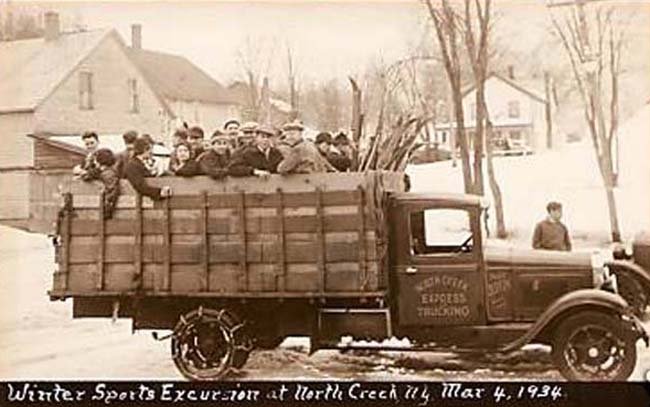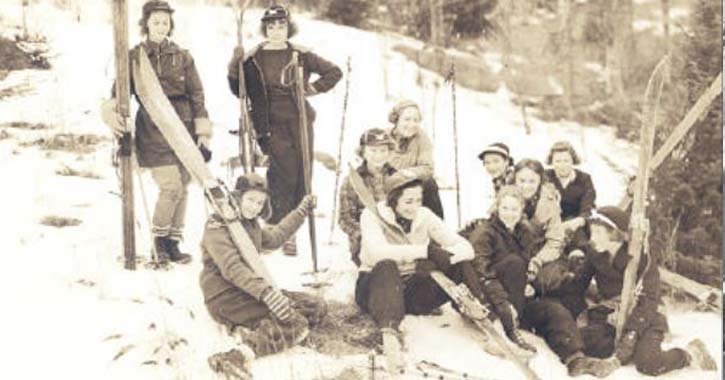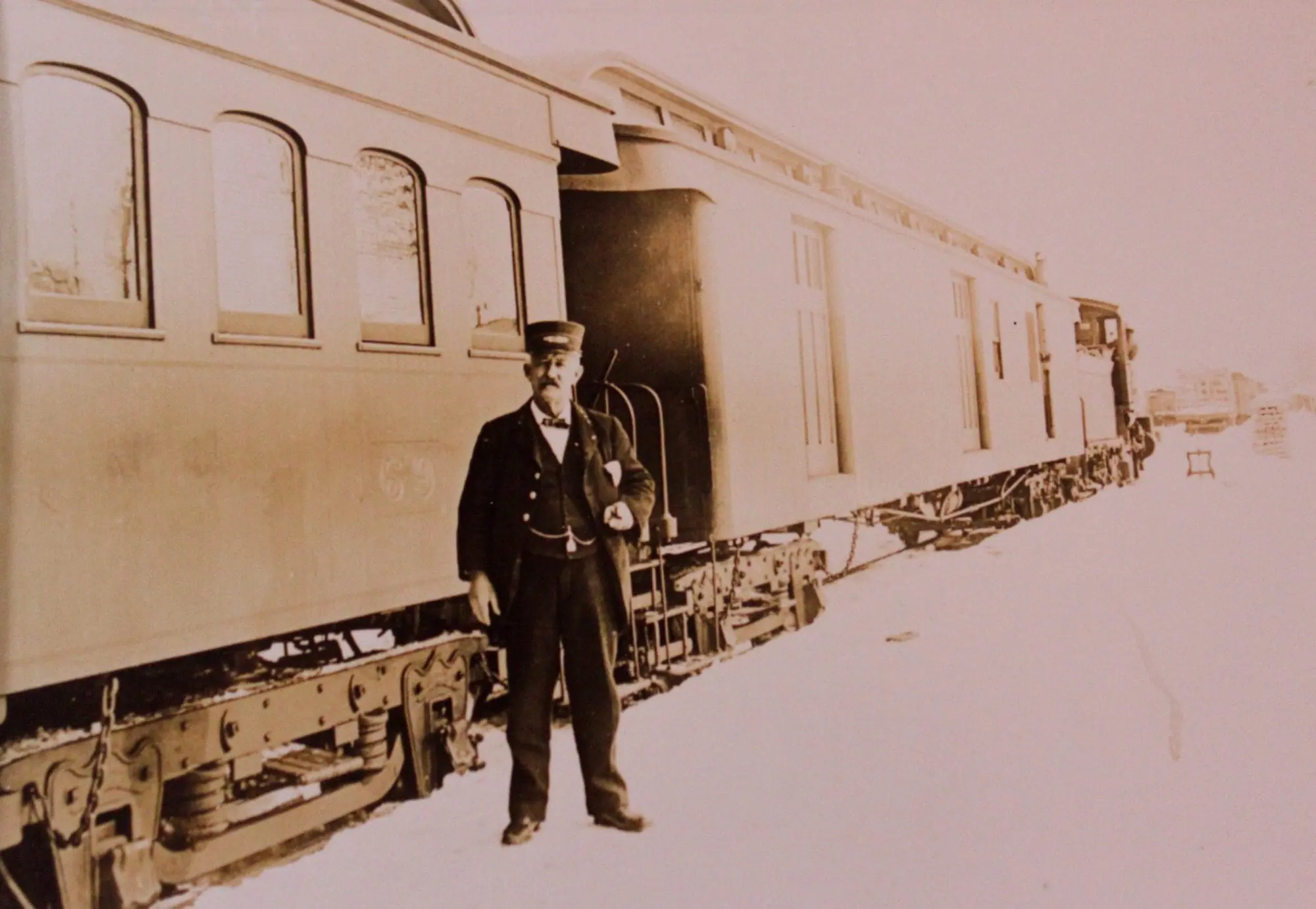Celebrate the 90th Anniversary of the First Snow Train’s Arrival in North Creek
Snow Trains helped make the Adirondacks a skiing destination in the Northeast.
Snow Train passengers arriving in North Creek.
This winter, the North Creek community celebrates the 90th anniversary of the Snow Train that brought skiers to the area and kick-started generations of winter tourism in the Adirondacks.
On March 4th, 1934, the first Snow Train arrived at the North Creek train depot at 10:30 am with 374 skiers, setting in motion a long history of winter fun in the Gore Mountain area.
In 2024, North Creek and the Town of Johnsburg, along with local businesses, ski history enthusiasts, and area residents, will celebrate the Snow Train’s 90th anniversary with various events and unique attractions.
New York State’s first skiing destination.
The origins of skiing in the Adirondacks trace back to as early as 1903, with skiing gaining popularity through the 1920s and early 1930s. The 1932 Winter Olympics in nearby Lake Placid ignited enthusiasm for winter sports throughout the region.
Skiers boarding trucks to take them to the top of the ski bowl in North Creek.
As the story goes, Schenectady native Vincent Schaefer wanted to create a ski destination in the Adirondacks. He explored the entire Adirondack region and identified North Creek as the perfect location for what would become the North Creek Ski Bowl. In November 1932, Schaefer founded the Schenectady Wintersports Club and organized ski trail construction in North Creek.
In 1934, the North Creek Ski Bowl opened for skiers and helped pave the way for skiing in the Gore Mountain Region. The popularity of the Ski Bowl snowballed, prompting Schaefer to organize efforts to bring skiers by train to North Creek in the winter. His group successfully lobbied various railroad companies to establish trips to North Creek and its burgeoning Ski Bowl.
“Ride Up, Slide Down”.
On March 4, 1934, the Delaware and Hudson Railroad Company inaugurated the first-ever Snow Train, carrying nearly 400 skiers from Schenectady to North Creek. When skiers got off the Snow Train, they would ride in the back of a truck to the top of the slopes. Wintersports Club member Bill Gluesing best described this practice as "Ride Up, Slide Down," which would become a slogan for the region.
New York State’s first rope tow at the North Creek Ski Bowl.
The Ski Trains were affordable round-trip adventures, priced at $1.50 (equivalent to $34.50 today) per person, and were met with tremendous enthusiasm and helped to transform North Creek into a skiing destination. By 1936, Snow Trains were departing from Albany and New York City, ushering in an era of increased tourism that significantly bolstered the local economy during the Great Depression.
As the site grew in popularity, Vincent Schaefer's brother, Carl Schaefer, a noted Adirondack conservationist, chose the Ski Bowl as the home of New York State's first ski tow. One of the first Ski Patrols in the U.S. was also established due to the Snow Trains.
Though the Snow Train era eventually concluded during World War II, its impact on the history of skiing remains indelible. From the 1940s-1960s, the North Creek Ski Bowl continued to grow in popularity.
In 1946, the Gore Mountain Ski Corporation, a partnership between the Gore Mountain Ski Club and investors, purchased the Ski Bowl's assets.
The organization’s goal was to improve ski lift service in the area, starting with a 3,000-foot electric t-bar lift. The lift created new trails and slopes, greatly expanding the Ski Bowl and reinforcing the area’s reputation as a winter attraction.
The fall and rise of the North Creek Ski Bowl.
However, as the 1960s unfolded, competition arose with the opening of the adjacent Gore Mountain ski area. As visitors skied at Gore Mountain, the Ski Bowl faced new difficulties keeping up. Although the Ski Bowl advertised and highlighted its shorter lift lines and uncrowded trails, the new Gore Mountain quickly became the area’s premier ski site.
North Creek was the site of the first organized ski patrol in the U.S.
Ownership of the Ski Bowl changed hands over the next few years, and attempts to transform it into a four-season resort failed. This was the start of a challenging period for the Ski Bowl as the main t-bar lift was left to decay, and the base lodge burned down.
However, in 2003, Gore Mountain partnered with the Town of Johnsburg and opened a snow tubing park at the Ski Bowl near the site of the first ski tow. Since then, the Ski Bowl has had a rebirth. Ski Bowl Village, a ski-in/ski-out site, was established, public skiing has returned, there is a terrain park, and the Hudson Chair ski lift now connects Gore to the Ski Bowl.
Visitors can enjoy alpine skiing and snowboarding, freestyle fun, cross-country skiing and snowshoeing, and more at this hub. Also, the site features snowmaking and lights so visitors can experience twilight skiing/riding.
Gore Mountain and the Ski Bowl provide outstanding recreational opportunities for the community and visitors and inject the area with significant sources of revenue and economic opportunity.
And it all started thanks to Vincent Schaefer, his vision for a local ski area and the travelers on the Ski Train.
Special events commemorate the Snow Train anniversary.
Throughout the 2023-2024 Snow Season, an array of fun and interesting events will illuminate the history and cultural significance of the North Creek Snow Train.
Snow Train conductor.
These events include walking history tours of the Train station and North Creek Ski Bowl, screenings of vintage films, presentations, concerts, artwork exhibitions, fun races, and commemorative giveaways, among other activities. Barkeater Chocolates is making a Snow Train chocolate bar, and Upper Hudson Coffee is branding the Roosevelt Roast with the Snow Train logo.
The full schedule of events is currently under development, with additional information forthcoming. For more information and to stay updated on the agenda of activities, visit The Tannery Pond Center’s Schedule of Events.
The events are a collaboration between the Town of Johnsburg, Gore Mountain, The Tannery Pond Community Center, The North Creek Depot Museum, The Johnsburg Historical Society, Revolution Rail Co., Cunningham’s Ski Barn, ski enthusiasts, historians, artists, residents, and local business owners.





